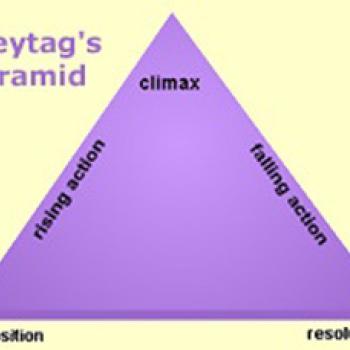

There's more to plot than identifying the series of events in a story. After viewing a PowerPoint presentation on plot structure, students identify the significant events that shape the structure of a familiar fairy tale, "Jack and the Beanstalk," using an online graphic organizer. Students then read short stories as a whole class, in small groups, and, finally, individually, analyzing the plot of three different short stories using an online graphic organizer to diagram the structures.
Elements of Plot PowerPoint Presentation: This PowerPoint presentation introduces the basic elements of plot structure.
Plot Diagram Interactive: Students can use this open-ended online tool to graph the plot of any story.
As Carol Jago explains, "It's easy to ‘teach' literary terminology and devise quizzes on the terms, but to make the language of literature useful to readers, students need to practice using academic vocabulary in ways that deepen their understanding of how stories work" (51). Emphasizing the connection between reading and writing, this lesson combines collaborative, small-group, and individual learning activities using literature circles and group investigations, as suggested by Harvey Daniels and Marilyn Bizar, to give students the opportunity to apply the literary terminology related to plot structures to short stories that they read together and individually.
Further Reading
This resource has been aligned to the Common Core State Standards for states in which they have been adopted. If a state does not appear in the drop-down, CCSS alignments are forthcoming.
This lesson has been aligned to standards in the following states. If a state does not appear in the drop-down, standard alignments are not currently available for that state.
Review the reflective journal entries that students write in response to the Reflective Journal Instructions to gauge their understanding of plot structures during Session Two. Ideally, review these entries before Session Three so that you can identify any concepts that need more exploration. Read both for specific details that indicate that students understand and can define the literary terms covered in the first session and for students’ tone as an indication of their confidence in their knowledge.
Assess the final essay students compose using the Writing Rubric. Focus your attention on evidence that students understand the difference between summarizing the story and its analyzing plot. Additionally ensure that students understand the key literary terms introduced during the lesson (exposition, rising action, climax, falling action, resolution).
After students read the novel The Color Purple, dialect is discussed and students write a short piece of fiction or poetry using the dialect of their peer group.
Professional LibraryJago offers a review of Freytag's Pyramid and an example of how work with the concept of plot structure positively affected student understanding and writing.
Student Interactive Organizing & SummarizingThe Plot Diagram is an organizational tool focusing on a pyramid or triangular shape, which is used to map the events in a story. This mapping of plot structure allows readers and writers to visualize the key features of stories.
Graphic OrganizerAfter students read a short story or chapter of a novel, they can use the Narrative Pyramid to reflect on key ideas and details.
Lesson Plan Standard LessonIn this alternative to the traditional book report, students report on their novel choices by rewinding the plot.